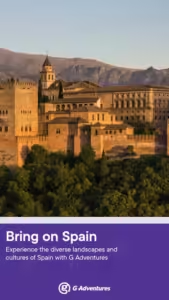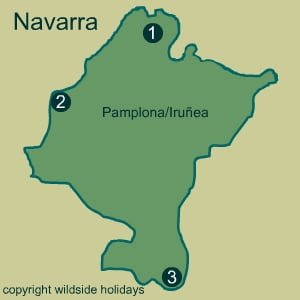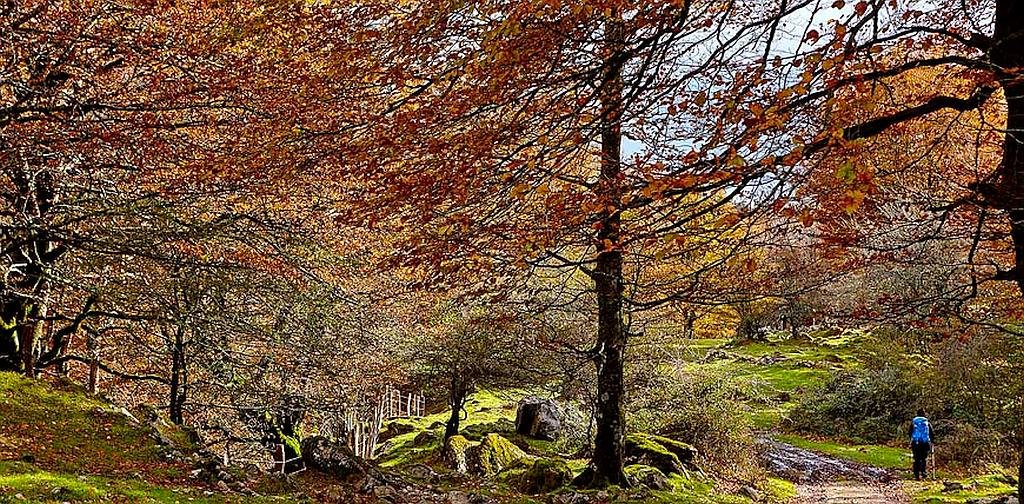Walking and wildlife holidays in Navarra
- Capital: Pamplona.
- Area: 10,391 km²

Navarra is a separate region from neighbouring Pais Vasco but a dialect of Euskera, the Basque language, is still spoken.
In medieval times Navarra was an independent kingdom controlling the Basque country throughout the Pyrenees and also a large part of Christian Spain.
The Roncesvalles mountain pass in the Pyrenees connects France and Spain and through the ages has been used by Romans, shepherds and smugglers. Now it is better known as the starting point in Spain for pilgrims on their way to Santiago de Compostela in Galicia (The Way of Saint James).

The exceptional Pyrenees mountains form the northern border (Pirineo Atlántico) and contrast with the fertile plains of the Ebro valley in the south. The Navarra Pyrenees highest peak is “Mesa de los tres Reyes” at 2444 metres.
The climate of the northern area is influenced by the Atlantic and the Ebro valley more than by the Mediterranean.
Hotels and other accommodations in Navarra
Navarra offers a wide range of accommodation options suited to every type of traveler, from boutique hotels and luxury stays in Pamplona to rustic rural lodges near the Pyrenees and Irati Forest. Visitors can choose from stylish city hotels with modern amenities, budget-friendly choices ideal for walkers on the Camino de Santiago, and countryside guesthouses that highlight the region’s natural beauty.
Whether you’re exploring historical towns, hiking mountain trails, or enjoying local cuisine, Navarra’s lodging options provide comfort, charm, and convenience across the region. Check out the options over at Booking.com
Tours in Navarra from Viator
Navarra has a vast array of sites to visit and enjoy. Below are some of the options listed on the Viator website. (We recieve a small commission if you book a tour which doesn’t cost you more and helps us to keep Wildside Holidays up to date with the best information.)
Natural parks in Navarra

Navarra offers an extremely varied landscape. As you travel from north to south you can experience high peaks, large forests (including the oldest and largest beech forest in Europe), canyons that are home to many raptors such as Hoces de Lumbier and small lagoons in the Ebro valley. These wetlands provide ideal reserves for Purple heron, Great bittern and Night heron amongst many others.
Natural parks in Navarra
1 The Señorío de Bértiz Natural Park is located in the municipality of Bertizarana 49 kilometres north of Pamplona along the banks of the river Bidasoa. (Access is via the village of Oronoz in the Baztan valley or Oiergi in the Bertizarana valley).
2 The Urbasa-Andía Natural Park is covered by beech forest accompanied by other species such as yews, junipers and pines. There is a great diversity of fauna and flora inhabiting this area that includes 16 rugged peaks of over 1000 metres.
3 The Bardenas Reales Natural Park and Biosphere Reserve is a semi-desert region, or badlands in the southeast Navarra. The soils are made up of clay, chalk and sandstone and have been eroded by water and wind creating surprising shapes, canyons, plateaus, tabular structures and isolated hills, called cabezos. Vegetation is scarce in many places and the small streams that cross the area are dry for most of the year.
Looking for guided or self guided walking in Navarra?

Walking North Spain are located in San Sebastian in the heart of a fantastic area for holidays and mountain travel, trips and routes are arranged in most of northern Spain (Basque Country, Navarra, Western Pyrenees, La Rioja, Picos de Europa…), as well as in the French Basque Country and the French Pyrenees. https://wildsideholidays.co.uk/walking-north-spain/
Some stunning photography and scenery of the Irati forest in Navarre
The Irati Forest, found in the western Pyrenees, covers 17,300 h of the Navarre region in the Soule and Basse-Navarre provinces and Navarre. framed by Mount Okabe and Pic d’Orhy, it is the second largest and best preserved mixed beech-fir forest in Europe.
Other protected areas in Navarra
Navarra has an awful lot of smaller protected areas!
- Aztaparreta Reserva integral
- Lizardoia Reserva integral
- Ukerdi Reserva integral
- Labiaga Reserva natural
- Peñas de Itxusi Reserva natural
- San Juan Xar Reserva natural
- Irubetakaskoa Reserva natural
- Cueva Basajaun Etxea Lanz Reserva natural
- Mendilaz Reserva natural
- Putxerri Reserva natural
- Tristuibartea Reserva natural
- Foz de Iñarbe Reserva natural
- Poche de Chinchurrenea Reserva natural
- Foz de Gaztelu Reserva natural
- Larra Reserva natural
- Barranco de Lasia Reserva natural
- Nacedero del río Urederra Reserva natural
- Barranco de Basaura Reserva natural
- Foz de Arbayún Reserva natural
- Foz de Benasa Reserva natural
- Foz de Burgui Reserva natural
- Peñalabeja Reserva natural
- Embalse de Salobre o de Las Cañas Reserva natural
- Monte de Olleta Reserva natural
- Monte del Conde Reserva natural
- Laguna del Juncal Reserva natural
- Acantilados de la Piedra y San Adrián Reserva natural
- Foz de Lumbier Reserva natural
- Caparreta Reserva natural
- Laguna de Pitillas Reserva natural
- Sotos del Arquillo y Barbaraces Reserva natural
- Sotos de la Lobera y Sotillo Reserva natural
- Sotos Gil y Ramal Hondo Reserva natural
- Vedado de Eguaras Reserva natural
- Soto del Ramalete Reserva natural
- Soto de la Remota Reserva natural
- Balsa de Agua Salada Reserva natural
- Balsa del Pulguer Reserva natural
- Rincón del Bu Reserva natural
- Caídas de la Negra Reserva natural
- Soto Quebrado, el Ramillo y la Mejana Reserva natural
Monumentos naturales in Navarra
Natural monuments are elements of singular landscape, geological and / or historical value – from a hundred-year-old tree to a forest or a cave – whose conservation advises a special type of protection.
Nararra has a lot of individual natural monuments (all trees) spread over the region. Below is the list and the nearest town village where they are located.
Many of these natural monuments are located in areas where a bit of a hike is required to see them. Others are in the centre of the town or village. Always ask in the nearest information centre as they have the most up to date information on access to the areas where the trees are located.
There is an Issuu publication here (In Spanish) detailing locations and descriptions of each natural monument.
https://issuu.com/rutasnavarra/docs/amnavarra
1.Encina de Eraul
- Quercus ilex L. subsp. ilex x Quercus ilex subsp. ballota (Desf.) Samp.
- Town, village: Eraul
2. Encino de las Tres Patas
- Quercus ilex L. subsp. ilex
- Town, village: Mendaza
3.Encina de Cábrega
- Quercus ilex subsp. ballota (Desf.) Samp.
- Town, village: Mués

4. Encinas de Corella (3 trees)
- Quercus ilex L. subsp. ilex x Quercus ilex subsp. ballota (Desf.) Samp.
- Town, village: Corella
5. El Centinela
- Quercus faginea Lam.
- Town, village: Zudaire
6. Quejigo de Rala
Quercus faginea Lam.
Town, village: Lónguida
7. Quejigos de Learza (12 trees)
- Especie: Quercus faginea Lam.
- Town, village: Etayo
8. Roble de Jauntsarats I
- Quercus robur
- Town, village: Jauntsarats
9. Roble de Jauntsarats II
- Especie: Quercus robur
- Town, village: Jauntsarats
10. Roble de Eltzaburu
- Quercus robur
- Town, village: Eltzaburu
11. Roble de “El Bocal”
- Quercus robur
- Town, village: Fontellas
12. Roble de Garaioa
- Quercus petraea (Matt.) Liebl. x Quercus humilis Mill.
- Town, village: Garaioa
13. Haya de los tres brazos
- Fagus sylvatica
- Town, village: Orbaitzeta
14. Haya de Nabala
- Fagus sylvatica
- Town, village: Orbaitzeta
15. Roble de Azanza
- Quercus humilis Mill.
- Town, village:Azanza
16. Avellanos de Orion (5 trees)
- Corylus avellana
- Town, village: Orbaitzeta
17. Álamos de Lodosa (19 trees)
- Populus alba
- Town, village: Lodosa
18. Sauce de la Presa del Molino
- Salix alba
- Town, village: Sangüesa
19. Arce de Orion
- Acer campestre
- Town, village: Orbaitzeta
20. Morera del Castillo de Olite
- Morus nigra
- Town, village: Olite
21. Espino de Azparren
- Crataegus monogyna Jacq.
- Town, village: Azparren
22. Nogal de Garde
- Juglans regia
- Town, village: Garde
23. Roble de Santa Isabel
- Especie: Quercus robur
- Town, village: Cortes
24. Abetos de Leitzalarrea
- Especie: Abies alba Mill (53 trees)
- Localización: Leitza
25. Sequoya del Palacio de Diputación
- Sequoiadendron giganteum (Lindl.) Buchholz
- Town, village: Pamplona
26. Encina de Basaura
- Quercus ilex subsp. ilex
- Town, village: Améscoa Baja
27. Cedro de Bertiz
- Cedrus libani A. Rich.
- Town, village: Señorío de Bertiz, Oieregi
28. Enebro del Caserío Equiza
- Juniperus oxycedrus
- Town, village: Arce
29. Pinos de Surio
- Pinus sylvestris (6 trees)
- Town, village: Uztárroz
30. Tejo de Otsaportillo
- Taxus baccata
- Town, village: Sierra de Urbasa
31. Tejo de Auztegia
- Taxus baccata
- Town, village: Ochagavía
32. Enebro de Legardeta
- Juniperus oxycedrus
- Town, village: Villatuerta
33. Haya de Limitaciones
- Fagus sylvatica
- Town, village: Limitaciones de las Améscoas
34. Arce de Lezáun
- Acer monspessulanum
- Town, village: Lezáun
35. Roble de Lizarraga
- Quercus humilis Mill.
- Town, village: Lizarraga de Izagaondoa
36. Sequoya del embalse de Domiko
- Sequoia sempervirens (D.Don) Endl.
- Town, village: Lesaka
37. Tejo de Etxalar
- Taxus baccata
- Town, village: Etxalar
38. Peral de Bera
- Pyrus cordata Desv.
- Localización: Bera
39. Acebo de Bera
- Ilex aquifolium
- Localización: Bera
40. Majuelo de Leitza
- Crataegus monogyna Jacq.
- Town, village: Leitza
41. Quejigo de Garínoain
- Quercus faginea
- Town, village: Garínoain
42. Roble de Echagüe
- Quercus humilis Mill.
- Town, village: Echagüe
43. Roble de Orkin
- Especie: Quercus robur
- Town, village: Arraitz-Orkin
44. Encinas de Olóriz (5 trees)
- Quercus ilex subsp. ballota
- Town, village: Olóriz
45. Robles de Irañeta (5 trees)
- Quercus robur x Quercus humilis Mill.
- Town, village: Irañeta
46. Nogal de Mélida
- Juglans regia
- Town, village: Mélida
47. Roble de Etxarri-Aranatz
- Quercus petraea (Matt.) Liebl.
- Town, village: Etxarri-Aranatz
Frequently Asked Questions About Walking and Wildlife Holidays in Navarra
Navarra offers exceptional variety in landscapes and ecosystems within a compact area. From the rugged Pyrenees in the north—with the 2,444 m Mesa de los Tres Reyes peak—to the arid plains of the Ebro Valley in the south, it’s ideal for holidays focused on nature, hiking, and culture. Visitors can explore vast beech forests like Irati, deep canyons such as Hoces de Lumbier, and bird-rich wetlands. Culturally, Navarra’s past as an independent kingdom and the presence of Euskera (Basque language) in the north add historical depth to the region. Pamplona, famous for the San Fermín festival, is the capital.
Navarra’s geography directly shapes its climate zones. The northern Pyrenees are influenced by the Atlantic, with cool, wet conditions supporting dense forests. In contrast, the Ebro Valley in the south experiences a drier, more continental climate with hot summers and limited rainfall. This contrast allows diverse flora and fauna to thrive within a relatively small area of 10,391 km².
Navarra is home to several natural parks with distinct ecosystems:
Señorío de Bértiz Natural Park: Lush forest trails along the Bidasoa River.
Urbasa-Andía Natural Park: Expansive beech woods and rugged karst landscapes with peaks over 1,000 m.
Bardenas Reales Biosphere Reserve: A unique semi-desert of badlands, sculpted by erosion into cliffs, plateaus, and cabezos (isolated hills).
Each park offers opportunities for wildlife observation, hiking, and scenic photography.
Navarra is a top destination for hiking, with options ranging from high-mountain treks to forest paths and river gorges.
The Roncesvalles Pass is the starting point for many pilgrims on the Camino de Santiago.
Irati Forest offers well-marked trails through Europe’s second-largest mixed beech-fir forest.
Walking North Spain, based in San Sebastián, provides guided and self-guided walking holidays across Navarra and the Pyrenees.
Navarra’s protected areas are havens for wildlife. Raptors such as griffon vultures and eagles frequent the canyons, especially Hoces de Lumbier. Wetlands in the Ebro Valley attract species like Purple Heron, Great Bittern, and Night Heron. The diverse climate zones also support amphibians, reptiles, mammals like wild boar and red deer, and a rich array of insects.
“Natural Monuments” in Navarra are protected natural features of ecological or cultural significance. Many of these are ancient trees, such as the Encina de Eraul (oak), Roble de Jauntsarats, and sequoias or yews scattered across the region. These trees are preserved due to their size, age, or cultural history, and some require short hikes to access.
Navarra goes beyond national and regional parks by maintaining numerous smaller protected areas like Reservas Naturales and Reservas Integrales. These safeguard key habitats such as:
Aztaparreta (old-growth forest),
Foz de Lumbier (gorge habitat),
Laguna del Juncal (wetland ecosystem).
This network ensures long-term biodiversity conservation across the region.
Navarra played a key role in medieval Spain as an independent kingdom, influencing large parts of the Basque region and Christian Spain. The Roncesvalles Pass was a strategic route for Romans and traders, and today it’s a symbolic start to the Camino de Santiago. Navarra’s layered history is visible in its castles, monasteries, and towns like Pamplona, blending tradition with natural beauty.
Whether you’re exploring historical towns, hiking mountain trails, or enjoying local cuisine, Navarra’s lodging options provide comfort, charm, and convenience across the region. Check out the options over at Booking.com
About the author of this article.
I’ve been living in this lovely area of Western Andalucia for the last 20 years or so and dedicate most of my time to the running of English language tourist information websites for the towns of Cádiz, Ronda, Grazalema, the famous or infamous Caminito del Rey, and also Wildside Holidays, which promotes sustainable and eco-friendly businesses running wildlife and walking holidays in Spain.

